Designboom is a publication and blog that focuses on design, architecture, art, photography and graphics. Their main offices are located in Milan, Italy, but for the hot summer months, the crew of Designboom recently moved their offices into a series of cargo containers on the island of Sardinia. Their DIY adventure was profiled in a recent post on their website and the results are a beautiful representation of relaxed, sustainable living (and working) on a desert island in the Mediterranean.
The government of Sardinia has adopted some strict criteria for building permits on the island to curb overbuilding. However, one way to get around the long permit waiting period is by using temporary or modular structures as housing. Designboom purchased three used cargo containers and crane-lifted them onto natural stone pavement since the team did not want to use any concrete in the construction. The outdoor flooring is made from local stone and dry set with sand and mortar. The containers are placed at 90 degree angles to each other so that their external doors can be latched together to protect the dining area from the ocean winds.
The offices contain an outdoor kitchen and dining area with a reed matting cover. Two containers are a live/work area and the third separate shipping container serves as the bathroom, which has been fitted with a functioning toilet and shower. The exterior of the containers have been painted with a ceramic coating called SUPERTHERM® that insulates the structures, the interior walls were painted with water-based sky-blue color and a dark plywood floor was placed over the containers’ subfloors. The entire place has electricity and is plumbed.
Photos courtesy of Designboom
By Christina Nellemann for the [Tiny House Blog]

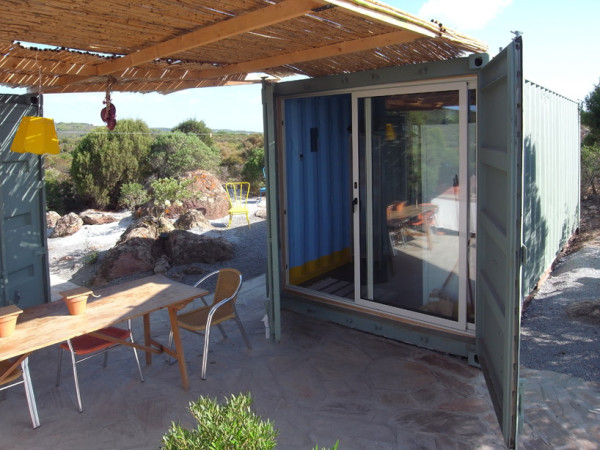
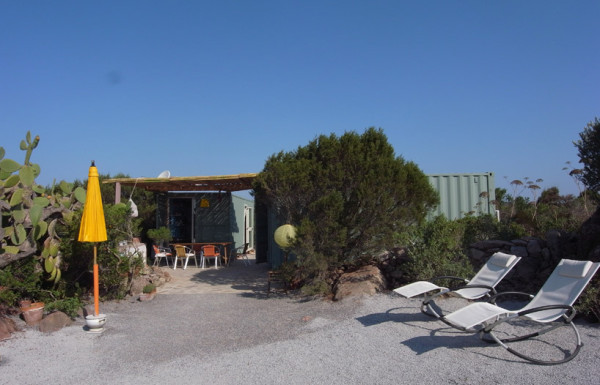
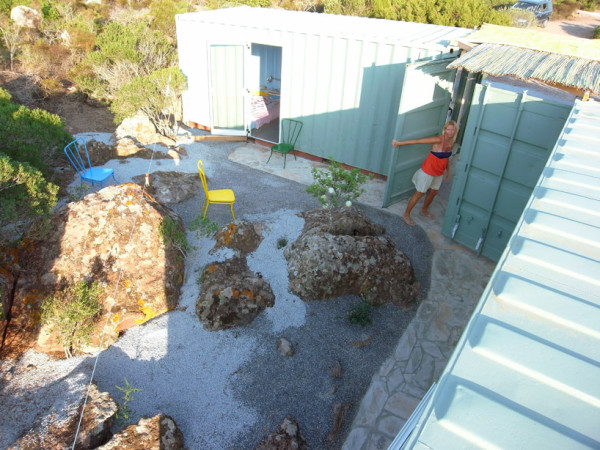

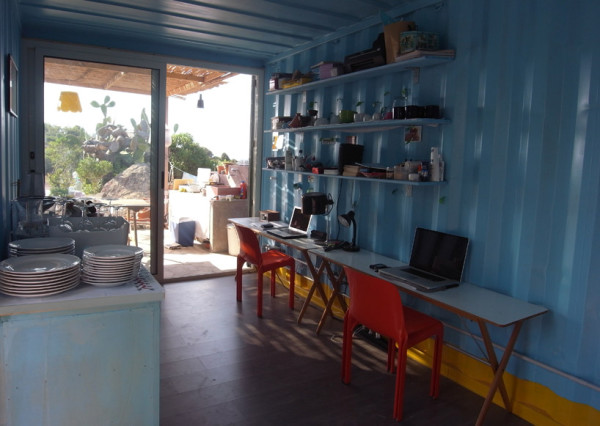

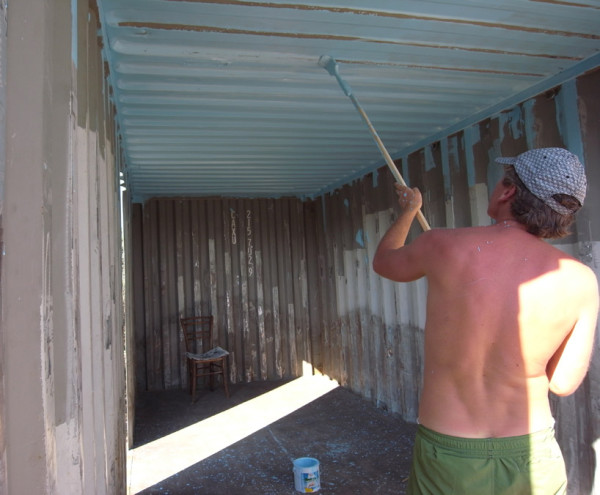
That is so incredibly cool. It makes living in a shipping container seem cool, which is hard to do.
a shipping container is as versatile as your imagination.
Simple, aesthetically pleasing, and practical! I’d love to see the whole process…
It’s unfortunate that people are still falling prey to the insulating paint scam, and that you have a link to SUPERTHERM in the article. If anyone is even remotely thinking about using this stuff, I urge you to visit the following links:
Insulating Paint Merchants Dupe Gullible Homeowners
Courts Bar Firms from Making Deceptive Claims for Home Insulation Products
Insulation Paint Claims
Steve,
Thanks for the heads-up on the insulation paint claims. Especially in the emerging “green” market, it’s a free-for-all and buyer beware!
I’ve always known that the so called “insulating” paint is a joke. The amount of insulation power it produces is so minimal that it’s basically worthless. OF course, it does make whatever you’re painting, prettier! That’s all though. Now, on a trailer house roof, painting it with white elastomeric roof coating, will make it a little cooler, but, not much!!
Blogging from Sardinia! Sounds like a rough life- lol. Damn! Very cool….
Totally awesome! Once we have a place to land, this is on my list of maybes!
I love how they’re linked with the doors to create a private, shielded outdoor space. How neat! I also love the idea of having three to contain different spaces. That could be applied to an individual living situation too. Thanks for the tip on another Design site. I love following them.
I am having a really hard time understanding how people involved with design would still choose a shipping container as a habitable structure.
Unless sanded back to the bare metal, shipping containers are highly toxic. The paint used on these containers is designed to keep them from rusting in a highly corrosive environment. Unfortunately this also means that these paints can be dangerous to human health.
Love it! Gotta have it! It is such a great idea to make use of used shipping containers for this kind of retreat. I live in an area where forest fires are is seems a good approach to minimize the risk…
sounds like giant ovens to me.
A giant oven is right!! For comfort, these containers must be insulated well, just like any structure. However, I believe that a layer of 1′ thick insulation sheets (4’X8′) with aluminum foil on both sides will do an amazing job for these containers. Of course, the thicker the insulation board, the better! I have used the Styrofoam boards for many different applications, and, they are absolutely amazing at insulating. But, the best thing is to have a separate cover to keep the shade the container from the sun. Shade is the best way to turn the heat.
OOPS, should have proof-read the last comment before posting. I didn’t mean to cover both sides of the wall with the styrofoam insulation, I meant that the insulation is covered on both sides with aluminum foil. And, I meant to “have a separate cover to shade the container from the sun”….simply another metal roof over the container, even a flat roof cover of R-Panel roofing tin, just a little higher than the container roof. It can be attached to the container roof, but, not touching it.
One must admire the process and progress that has been made in the use of Container living. The Repurposing alone, is a great start. I am sure there is some type of radiant barrier that will work for containers as well as a way to remove all of the toxic paint. Sandblasting maybe? I applaud you all.
I think I’d need some windows; I’m curious how big a welding/cutting torch job it is to remove 6 sq. ft. sections of the sides of those containers?
I have always liked the idea of having a center court yard configuration for housing. I had such a place once (rental) in California. Four separate spaces each down hallways that connected at 90 degree angles with a Mexican tile center patio and an outdoor kitchen with an in-ground lemon tree for shade. I can see using these containers, once fitted out properly and healthfully, could be configured in the same way, say in the southwest, like south of I-40 in New Mexico. Nice 🙂
I would so love to try this in the USA if I could get a piece of land. I adore the whole idea
Enjoyed reading your post!
This site has always been WONDERFUL! creative, outside of the box thinkers,dreamers, futuristic thinkers, conservationist, wisdom of some of the old timers that know how things really work and how these techniques can apply today. This site also can be totally TERRIFYING!..yeah!; for REAL! Sooooo….
Please don’t go sandblasting anything, particularly shipping containers. We’ve been aggressively eliminating or safely protecting our environment and our children from lead paint(brain damage) and asbestos for the past 40 years. We are having to fight lead all over again in most of our imports from primarily China, due to little or no regulation; a problem from our past, that global corporations aren’t interested in.
NOTE: Shipping Containers; besides the toxic paint that needs to be very carefully removed, these containers have been all over the world and loaded with every kind of legal and illegal cargo and substances known and unknown to man. With toxic clean-up from the wars, etc. you could have low levels of spent uranium. Even in the US construction containers are allowed to have a limited amount of toxic substances/load, that’s found in most demolition.
PLEASE: Don’t even entertain the idea of using a container in a forest fire. Your only hope is to suffocate before the cooking begins.
Freebies, if you’re still reading:
A)Someone said it earlier; “there’s no such thing as insulating paint.” A glossy white and the silverish & whiteish coatings on the top of mobile homes and RV’s are those colors to reflect as much heat as possible, but are not insulation.
B)In the madness out there today: everything advertised as “green” is not “green, and may not be safe or close to being as durable as they claim; and many of the truly good products can be worthless if installed improperly[there are a lot of people out of work right now]
C)All of the many professions(including the ones here) involved in the creation of a structure are not trained and don’t always know if their part is going to fit with the other professions. Just because a person can imagine it, doesn’t mean it can be built, and; if it might possibly be constructed, it still may never be safe for use by the public.
I LIKE it!!
Cool use of something otherwise scrapped.
Congratulations
It’s a pity that such a beautiful color scheme is only in WMNS specifications, which may disappoint the male fans.